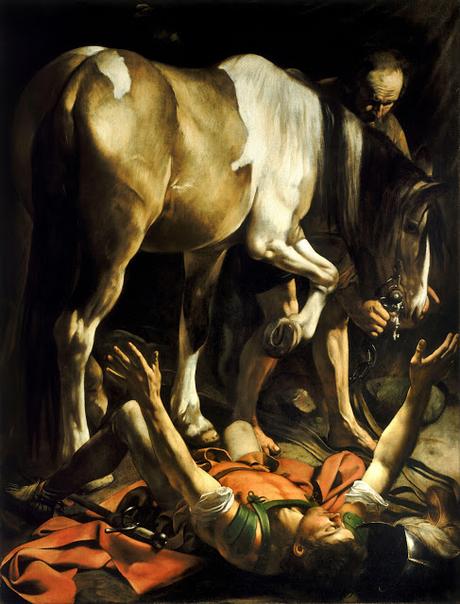
Il dipinto odierno rappresenta la Conversione di San Paolo, interpretata da uno dei più grandi pittori del panorama artistico italiano e mondiale di tutti i tempi:Michelangelo Merisi, meglio noto come il Caravaggio.Le figure religiose furono molto care al pittore, che ne realizzò un numero importante su commissione e non. A primo impatto, la prima cosa che si nota è la semplicità dello sfondo. La scena è ricca di dettagli, ma si dipana al buio del terreno di una stalla, molto probabilmente, l'ultima tappa prima della sua conversione sulla via di Damasco.. Essa rappresenta il momento in cui Saulo - poi ribattezzato Paolo dopo aver trovato la fede - cade dal suo cavallo, in preda alla folgore divina. Delicatissima è la tecnica con cui il Merisi rende il movimento del cavaliere con le braccia protese, mentre viene accecato dalla luce Santa. I tendini tesi della mani, queste ultime istintivamente aperte nel tentativo di aggrapparsi durante l'inaspettato volo. I toni scuri del dipinto evidenziano uno stato di desolazione e buio, quello che Saulo vive all'interno della sua anima prima di incontrare il Signore. Il cavaliere ha con se' elmo e spada, che a nulla valgono in questa circostanza. Nell'opera si scorgono poi, altre due figure: quella del suo vecchio palafreniere è in secondo piano, mentre il destriero è soggetto centrale, che occupa quasi lo spazio dell'intera tela. L'espressione dimessa del cavallo nell'osservazione del padrone è inquietante, tuttavia, è possibile constare come l'animale abbia un sentimento di pietà nei confronti dell'uomo; il gesto di sollevare la zampa per non calpestarlo ne è la prova più significativa.Una tela che nella sua semplicità è ricca di sapienza e dettagli minuziosamente studiati. mentre le luci forniscono allo spettatore tutto il pathos che il Caravaggio intende trasmettere come di consueto in tutte le sue opere.
Today's painting represents the Conversion of St. Paul, played by one of the greatest italian and international painters of all time: Michelangelo Merisi, well known as Caravaggio.Religious figures were very dear to the painter. At first glance, the thing you notice is the simplicity of the background. The scene is full of details, but unfolds in the dark soil of a stable, most likely, the last stop before his conversion on Damascus road . This is the time when Saul - later renamed Paul after finding faith - falls from his horse, in the throes of divine lightning. Delicate is the technique by which the Merisi makes the movement of the rider with his outstretched arms, while being blinded by Hhly light. The tendons of the hands, the latter instinctively open in an attempt to hold something during the unexpected flight. The dark tones of the painting highlight a state of desolation and darkness, what Saul lives inside his soul before meeting the Lord. The knight got his helmet and sword, which are worthless in this circumstance. In the work you can see then, two other figures: that of his old groom is in the second floor, while the horse is the central subject, which occupies almost the entire canvas space. The resigned expression of the horse in the observation of its master is disturbing, however, it shows hoow the animal got a sense of loyalty to the man; the gesture of lifting its leg to step on it is the most significant evidence.The painting in its simplicity is rich in wisdom and details minutely studied. while the lights give to the viewer all the pathos that Caravaggio intends to broadcast as usual in all his works.






